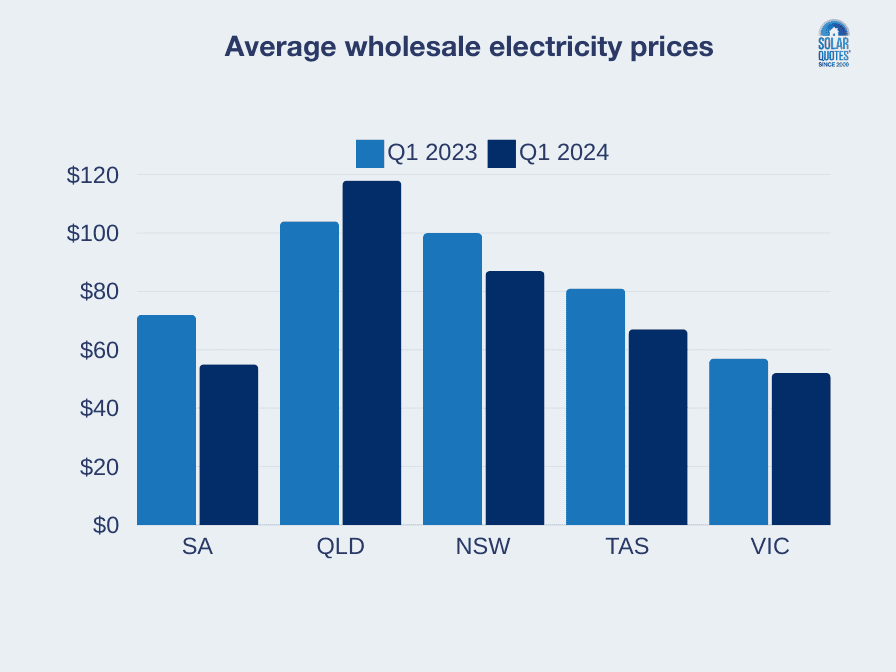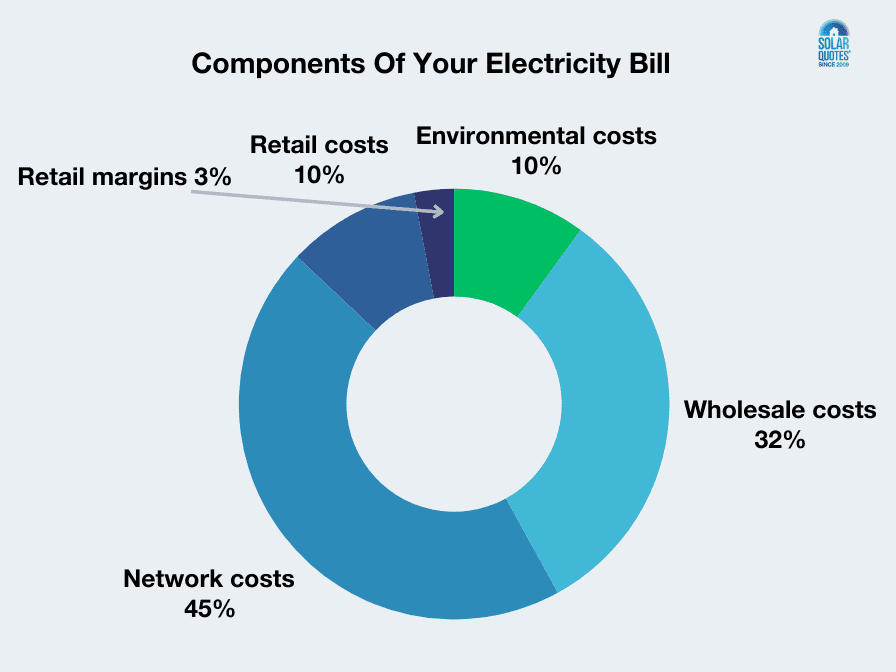
The latest AEMO quarterly report published on Tuesday indicates average wholesale electricity prices for the first quarter of this year dropped significantly in most NEM regions. But relief in power bills won’t match, and in some cases they could continue to rise.
In a nutshell, here’s how National Electricity Market (NEM) states shaped up during the first quarter of this year compared to the first quarter of 2023.
- South Australia: $55/MWh (down 24%)
- Queensland: $118/MWh (up 13 per cent)
- NSW: $87/MWh (down 13 per cent)
- Tasmania: $67/MWh (down 17 per cent)
- Victoria: $52/MWh (down 8 per cent)
- Source: AEMO
SA Energy Minister Tom Koutsantonis was quick to bathe in the glory of South Australia’s result.
“South Australia’s high proportion of renewables – which exceeded 75 per cent of generation in 2023 – is key to South Australian prices being far lower than the black-coal states of NSW and Queensland,” he said.
South Australia has oodles of renewables because it has traditionally had higher electricity prices – not the other way around.
How Much Will Households Save?
Before households get too excited, electricity bill reductions in states that saw wholesale cost drops won’t be matched. This is because wholesale costs are only one element of retail electricity pricing. The components are:
- Wholesale costs (~32 per cent of the total cost)
- Network costs (~45 per cent)
- Environmental costs (~10 per cent)
- Retail costs (~10 per cent)
- Retail margins (~3 per cent)
- Source: ACC (for 2020-21)
To get an idea of where prices are heading, look to the Australian Energy Regulator, which released its draft determination of the Default Market Offer (DMO) for 2024-25 last month. The DMO, also known as a Standing Offer, is a plan electricity retailers must make available to residential and small business customers who don’t opt for a market offer. This is to prevent these customers from getting ripped off more than they otherwise would.
While most households would be on a market offer (on a related note, you can compare electricity plans here), the DMO sets the general scene for pricing direction.
In its draft determination, the AER says the majority of residential customers could have reductions of between 0.4% to 7.1%, but some may have increases between 0.9% and 2.7%.
For those who will benefit from decreases, it won’t make a massive difference to budgets but is better than a poke in the eye with a sharp stick. For others who will be whacked with increases, it’s another very unwelcome ingredient added to the price of living pressure cooker.
Households putting off going solar in the hope their electricity bills will drop significantly soon might want to re-evaluate that position and get cracking on installing solar panels. With prices of solar systems as low as they are they are and financing options available (note: approach finance with care), it’s not so much a case of whether households with a suitable rooftop can afford to install a system, but more whether they can afford not to.
Discover how much you could save on home energy costs with SQ’s solar and battery calculator.



 RSS - Posts
RSS - Posts



Woolworth claim to be aiming to be almost fully switched to renewable energy sources during 2025 see: https://www.woolworthsgroup.com.au/au/en/sustainability/Planet/green-electricity.html
WW state that they are ‘one of the largest users of electricity across Australia and New Zealand’.; and mention that their OZ electricity consumption represents just over 1% of Oz’s total demand. Cole’s have set a similar goal, Their total consumption, although slightly less than WW is also around the 1% level.
Energy bills for many consumers and small businesses are now so high, that a variety of government subsidies are now needed to assist them in such everyday activities as
– buying food and avoiding becoming either (or both) starving and homeless,
– enabling businesses to continue trading and to also pay wages to their employees and rent to landlords.
There are also rapidly escalating consequences due to climate change influences
This overall state of affairs has major implications for the futures of both energy retailers and distributors. This affects us all.
It might help some readers if Solar Quotes did a series of articles on how to achieve some degree of self-sufficiency in electricity supply via renewable sources. E.g:
1) what’s involved if you own your residence and decide to make just a portion of it totally independent from the grid. (partially off-grid, but living in an urban setting)
2) what are the most useful electricity generation items if you decided to camp out in your own back-yard. (similar to 1 above, but moving into a back-yard tent or caravan instead of rewiring your home).
3) the above is also relevant to renters.
A useful source for suitable devices is retail camping stores, but quality varies, & items can be very expensive.
The rapid increase in the number & magnitude of natural disasters through-out the globe, co-joined with politics, speaks for itself.
So I do see increasing urgency for some reliable guidance in this area.
Cheers Des,
We already have a few articles on off grid living & vanlife. Trawl back through my posts for more and let me know if there’s some detail you would like to expand on.
https://www.solarquotes.com.au/blog/electromobile-renewable-future/
Cheers
I understand the pie graph of how energy costs are broken up and it’s just not the wholesale price that makes up your electricity bill. But can someone explain why as the bills go up, possibly justifiable, but at thee same time FIT GOES DOW. mine has gone from 12 cents per kWh to 6 cents per kWh. Are we being screwed or am I missing something. In the words of one of our politicians “please explain”
Hi Tim,
Solar means that during the day there’s often a genuine surplus, glut or oversupply. Last October(?) in SA the spot price for power went negative at some point around the middle of every day. During these times it will actually cost your retailer FIT paid to you but also paid into the national market. Whereas after 3pm the calculations change… it’s all about time of use.
The 6c you get paid for FIT might be a good earner for the retailer if they have customers next door on a flat rate of 36c.
However TOU metering might also mean the neighbour has midday rates of 8c or a promotional “happy hour” of free electricity… and 75c peak rate after 5pm?
At the end of the day we all need more storage everywhere on the network.
Best advice is to get an EV and use it to soak up solar instead of buying petrol.
Thanks for the explanation
Item 1, I suspect they still get you with the Supply Charge.
What does get me though, and I live in Regional NSW and my FiT averages out at somewhere around 8c-9c. However it is ~220-240Vac, it is distributed locally and re-sold at normal prices.
In Northern New England these prices are Peak $0.4300/kWh; Shoulder $0.3750/kWh; O/P $0.2950/kWh.
I am sure quite a few people around export here far more than they use, And we all now have Smart Meters.
So why don’t we get a Rebate on the HV Poles and Wires Sectors that we aren’t using as that is being generated and resold, locally?
It can’t be a difficult programming change.
Comments, ideas?
Cheers
Denis
The electricity retailers were hoping nobody picked up on that…
We put solar on 17 years ago, then enlarged it several years later. With solar hot water, insulation and a wood heater (burning our own deadfall wood) we haven’t had a bill since. Usually get a small cheque for the positive balance each year. Our 44 cent feedback runs out in 3 years. Intend to get a new much bigger system then. May also get a RTG EV then.
I know of two pensioner couples who borrowed to get it, then paid off the loans from savings in 4 to 5 years.
Anyone who owns their own roof should get it.
So the wholesale costs dropping won’t automatically translate to lower overall bills “because it’s only a small percentage of the overall cost”. However I seem to remember 2 years ago when the wholesale costs were rising the retailers had no problems jacking up the prices and blaming exactly this.
Smells fishy.
Kind of like how the banks are happy to raise your rates within hours of a RBA decision if it benefits them, but slow to give you relief when it doesn’t.
Indeed the justifications for price rises are always predicated on some event that has increased the energy supply and they come in thick. My last was close to 28% increase.
One of the opportunities available with fuller roof top solar penetration and local area batteries, is the ability to not pay such a huge transmission cost. We should be able to buy power with a margin on the cost of generation, storage, and local distribution plus admin. The existing industry must be so wary of this that it is not being talked about at all.
There is so much effort put into levelling the costs across all involved infrastructure, so that traditional players are not marginalised in the future.
How about a capacity incentive for homes and businesses to add 20% over their needs on solar and battery installation sizes, to cover other local demand.
As I understand it the wholesalers and possibly the distributors were guaranteed a profit to encourage them to purchase the grid. The power prices are set to guarantee them a profit. Why did we sell it in the first place? I know it’s political expediency and not really relevant. What’s done is done and as usual the tax payer pays to privatise profits and socialise losses I am going off grid asap
“A small % of overall costs”.
This is how electricity retailers will continue to empty power users wallets for years to come, combined with slowly diminishing (or eliminating altogether) solar feed in, throttling feed in when there’s too much (it suits them).
A big enough system, and battery to handle ALL your use, the only way (for now) to beat the bills, or better yet build a bush bolt hole and go off grid altogether.
From what I read we in SA are in for a rise then ? Maybe 9% odd ?
That’s a total disparity, as we are already far and above all state average electricity prices, and paying up to nearly double what some do now.
ACT – 23.67
NSW – 33.84
NT – 27.37
QLD – 30.21
SA – 45.54
TAS – 28.12
VIC – 28.45
WA – 30.06
Absolutely disgraceful to see this in a country like Australia.
Hi Les,
Just a quick reminder that SA has a similar sized network to Victoria and around 25% of the population to pay for it. Electricity has always been expensive here (even before it was privatised and the price doubled)
With such a large stringy network, maintained by first world workers to first world standards can’t be incredibly cheap, but the prices in SA have risen least in the last few years. While Torrens Island A is 50 years old and retiring, reliability has only increased as more renewables are rolled out.
We’re now world leaders in rooftop solar and are running our entire grid between 70 & 80% renewable on a rolling yearly average.
This is good news, so you won’t read about it in the Awfultiser.
Yeah, I realise that is the main reason Anthony, thanks for the reminder.
I think households going totally self sufficient with decent solar system and a battery is the best way for us to get both households almost off the grid teat, and provide excess power to the grid to help keep SA’s great advancements in statewide household domestic supplied renewables.
VPPs are a way to help with this in the broader grid needs through the evenings, but many with solar and battery would probably be content to just be kind of ‘selfish’ in that way and keep it all in house.
Who can blame them with the way energy costs have gone / are going ?
We all feel ripped off to a degree, and that power companies / retailers are adding too much burden to daily cost of living (along with just about everything else !).